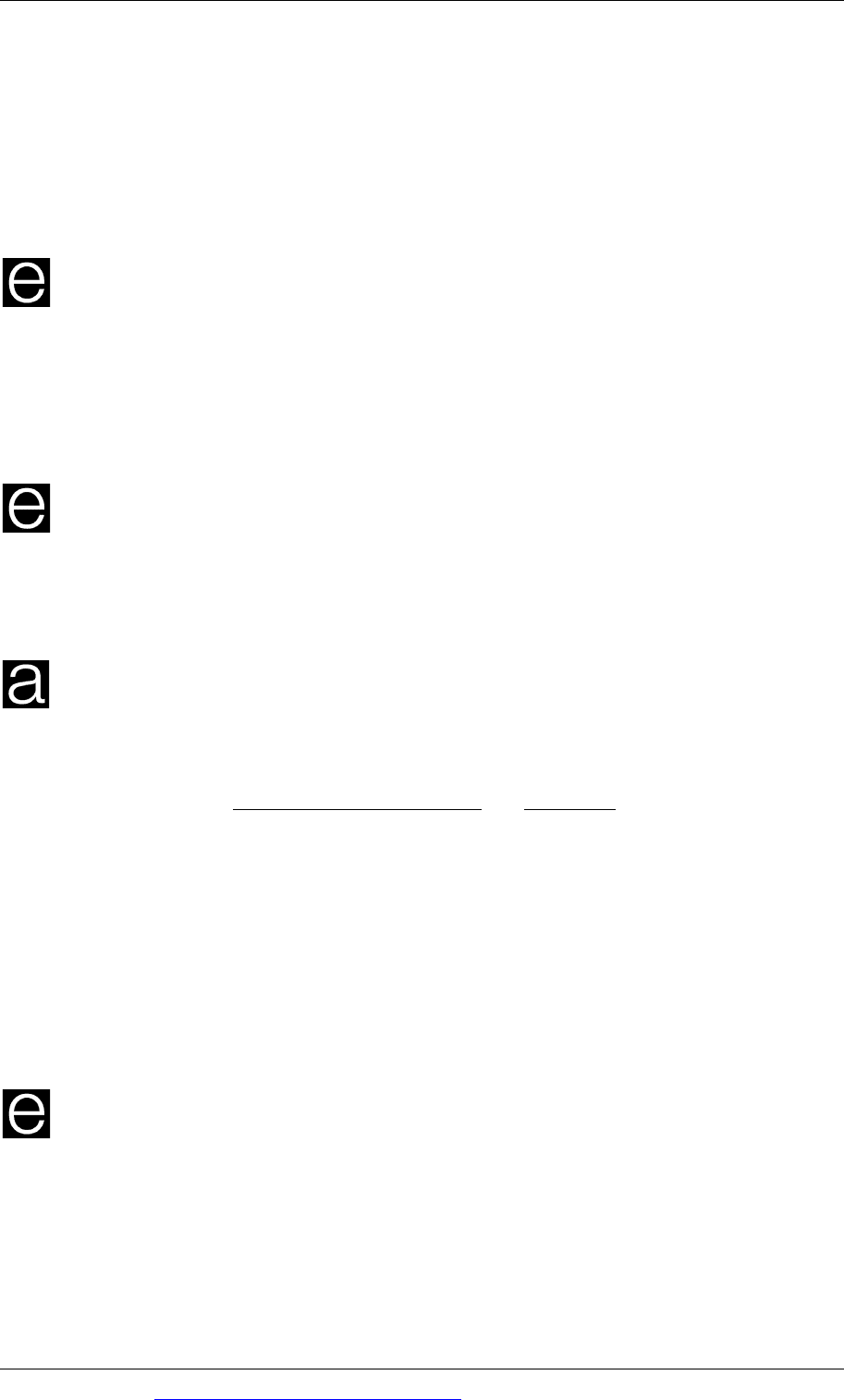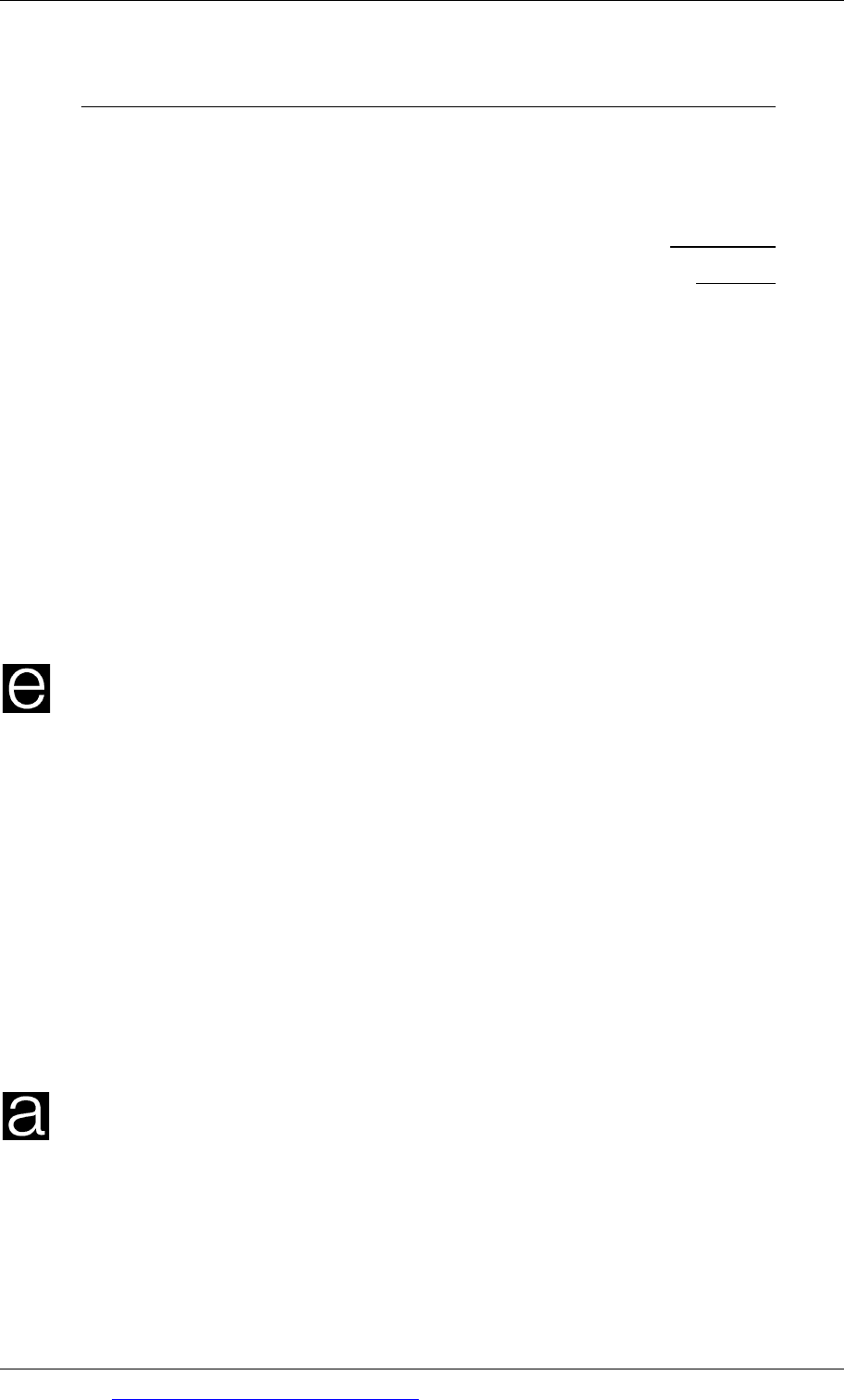ACCA F9 Financial Management - 2010 - Study text - Emile Woolf Publishing
Подождите немного. Документ загружается.


Chapter 18: Business valuations
© EWP Go to www.emilewoolfpublishing.com for Q/As, Notes & Study Guides 345
where:
i = amount of the regular fixed interest payment and
r
d
is the interest yield (before tax) required by the bond investor.
By convention, bonds are usually valued at an amount per $100 or €100 or £100
nominal value of the bonds.
Example
A 7% bond, denominated in euros, pays interest annually. The interest yield
required by the bond investors is 8%.
The value of the bonds (ex interest) is therefore €100 × (7%/8%) = €87.50 per €100
nominal value of the bonds.
Example
A 10% irredeemable bond, denominated in dollars, pays interest every six months.
The interest yield required by investors in the bonds is 8%
per annum. What is the
market value of these bonds?
Answer
If the annual cost of debt is 8%, the six-month cost of debt will be about 4%.
Valuation = Six-monthly interest = 5 cents
Six-monthly cost of debt 0.04
= 125.00
6.3 Valuation of redeemable fixed rate debt
The value of redeemable fixed rate debt is the present value of all future interest
payments on the bond to maturity, plus the present value of the principal
repayment at maturity, discounted at the interest yield on the bond.
Example
A dollar-denominated 6% bond pays interest annually, and has three years
remaining to maturity. It will be redeemed at par. The interest yield required by the
bond investors is 5% per annum. An annual interest payment has just been made.
The value of the bond is calculated as follows, for each $100 nominal value of the bonds.

Paper F9: Financial management
346 Go to www.emilewoolfpublishing.com for Q/As, Notes & Study Guides © EWP
Year
Amount
Discount
factorat5%
Present
value
$ $
1 Interest 6 0.952 5.71
2 Interest 6 0.907 5.44
3 Interestanddebtprincipal 106 0.864 91.58
Bondvalue
102.73
The bond will have a market value of 102.73 and at this price investors in the bonds
will receive an average annual return of 5% if they hold the bonds until maturity.
6.4 Valuation of convertible bonds
The market value of a convertible bond is the higher of:
the value of the bond as a straight bond that will be redeemed at maturity, and
the present value of future interest payments up to the time that the bonds can
be converted into shares, plus the present value of the expected market value of
the shares into which the bonds can be converted.
A convertible should therefore be valued by each of these methods, and its value
will be the higher of these two valuations.
Example
A company has issued some 4% dollar-denominated convertible bonds. These are
convertible into shares of the company in four years’ time at the rate of 25 shares for
every $100 bonds. Interest on the bonds is payable annually, and the current year
interest has just been paid.
The current market price of the company’s shares is $4.60, and shareholders expect
annual dividends to grow by 5% per year into the foreseeable future. The dividend
is paid annually and a dividend for the current year has just been paid.
The convertible bondholders require an annual return of 6% per year on their
investment.
What is the current price of the convertible bonds likely to be?
Answer
The current price of the convertible bond will be the higher value of the bond as a
straight redeemable bond redeemable in four years’ time and the value of a bond
that will be converted into shares in four years’ time.
The current share price is $4.60, but if dividends are expected to rise by 5% per year
into the foreseeable future, the share price will also be expected to rise at the same
rate. The expected share price in four years’ time is therefore: $4.60 × (1.05)
4
= $5.59.

Chapter 18: Business valuations
© EWP Go to www.emilewoolfpublishing.com for Q/As, Notes & Study Guides 347
Value of the convertible as a straight bond
Year
Amount
Discount
factorat6%
Present
value
$ $
1‐4 Interest 4 3.465 13.86
4 Redemptionvalue 100 0.792 79.20
Valueasstraightbond
93.06
Value of the convertible if shares are converted
Year
Amount
Discount
factorat6%
Present
value
$ $
1‐4 Interest 4.00 3.465 13.86
4 Valueofshares(25
×$5.59) 139.75 0.792 110.68
Value
124.54
The convertibles should have a current price of about $124.54.
(Note: In this example, by comparing the cash flows of the convertible as a straight
bond and the convertible if the bonds are converted into shares, it should be
obvious which has the higher present value. In this example, it should therefore be
unnecessary to calculate the PV of the convertible as a straight bond.)

Paper F9: Financial management
348 Go to www.emilewoolfpublishing.com for Q/As, Notes & Study Guides © EWP
Efficient market hypothesis (EMH)
The efficiency of capital markets and fair prices
The nature of capital market efficiency
The purpose of the efficient market hypothesis (EMH)
Weak form efficiency
Semi-strong form efficiency
Strong form efficiency
Implications of strong capital market efficiency
Factors that may have an impact on the market value of shares
7 Efficient market hypothesis (EMH)
7.1 The efficiency of capital markets and fair prices
Investors in securities such as shares and convertible bonds want to be confident
that the price they pay for their securities is a fair price. In order for market prices to
be fair, it is important that the stock market should be able to process the relevant
available information about companies and that investors should have immediate
access to this information and act on it when making decisions about buying and
selling shares.
The efficient markets hypothesis provides a rational explanation of how share prices
change in organised stock markets. The hypothesis is based on the assumption that
share prices change in a logical and consistent way, in response to new information
that becomes available to investors. The
speed with which share prices change
depends on how quickly new information reaches investors, and this varies with the
efficiency of the market.
7.2 The nature of capital market efficiency
There are four types of capital market efficiency:
Operational efficiency. A capital market is efficient operationally when
transaction costs for buying and selling shares are low, and do not discourage
investors from taking decisions to buy or sell.
Informational efficiency. A capital market is efficient ‘informationally’ when
available information about companies is processed and made available to
investors.
Pricing efficiency. A market has pricing efficiency when investors react quickly
to new information that is made available in the market, so that current share
prices are a fair reflection of all this information. For pricing efficiency to exist, a
capital market must also be operationally and informationally efficient.

Chapter 18: Business valuations
© EWP Go to www.emilewoolfpublishing.com for Q/As, Notes & Study Guides 349
Allocational efficiency. When there is allocational efficiency in a capital market,
available investment funds are allocated to their most productive use.
Allocational efficiency arises from pricing efficiency.
Research into stock market efficiency focuses on pricing efficiency.
Efficiency therefore refers to the speed with which information is made available to
the market, and the response of market prices to this information. In an efficient
market, all investors are reasonably well informed at the same time about new
developments that might affect market prices, so that some investors with ‘insider
knowledge’ cannot exploit their knowledge to make profits at the expense of other
investors.
If all relevant information is made available to all investors at the same time, all
investors are able to make decisions at the same time about buying or selling
investment, and about whether current prices are too high or too low.
Although the concept of market efficiency applies to all financial markets, it is
probably most easily understood in the context of equity shares and the equity
markets.
7.3 The purpose of the efficient market hypothesis (EMH)
The efficient market hypothesis (EMH) is a theory of market efficiency, based on
research into share price behaviour in stock markets. The purpose of this research is
to establish the extent to which capital markets show pricing efficiency.
According to this theory there are three possible levels or ‘forms’ of market
efficiency:
weak form efficiency
semi-strong form efficiency, and
strong form efficiency.
Each financial market can be categorised as being weak form, semi-strong form or
strong form efficient.
In equities markets, the way in which share prices move in response to available
information varies according to the efficiency of the market.
7.4 Weak form efficiency
The efficient markets hypothesis states that when a market has weak form
efficiency, share prices respond to the publication of historical information, such as
the previous year’s financial statements.
When the market displays a weak form, it also means that the current share price
embodies all the historical information that is known about the company and its
shares, including information about share price movements in the past. Until the

Paper F9: Financial management
350 Go to www.emilewoolfpublishing.com for Q/As, Notes & Study Guides © EWP
next publication of more historical information about the company, there is no other
information about the company that will affect the share price in any obvious way.
The weak form suggests that the current price reflects all past prices and that past
prices and upward or downward trends in the share price cannot be used to predict
whether the price will go up or down in the future. Share prices do rise and fall,
with supply and demand in the market, but the next price movement is equally
likely to be up as down.
Random walk theory (versus Chartism)
A weak form of stock market efficiency is consistent with the random walk theory.
This is the theory that share prices
move up and down randomly over time, in
response to the arrival of favourable or unfavourable information on the market.
Random walk theory is opposed to the view that future share price movements can
be predicted from patterns of share price movements in the past, since patterns
repeat themselves, and historical trends can be used to predict future trends. Some
stock market analysts believe that they can predict future movements in share prices
from recognisable patterns of share price movement. These analysts are sometimes
called
chartists, because recognisable patterns of share price movements can be
illustrated by graphs or charts of share prices over a period of time. Chartism does
not have a rational justification.
7.5 Semi-strong form efficiency
When a market has semi-strong form efficiency, current share prices reflect all
publicly-available information about the company and its prospects, in addition to
historical information. For example, share prices might respond to a new
announcement by a company about its trading prospects for the remainder of the
year. Similarly, the share price might also respond to an announcement that the
company is seeking to make a new acquisition, or a major new investment.
If a market displays semi-strong form efficiency, share prices should move when
new information becomes available to the public, but not before. For example, if a
company is planning a major acquisition, the share price should not be affected by
unconfirmed rumours in the market. However, the share price will react to the
official announcement of a takeover bid by a company.
It also means that individuals who have access to information that has not yet been
made public (‘
inside information’) will be able to buy or sell the shares in advance
of the information becoming public, and make a large personal profit. This is
because the inside information will indicate whether the share price is likely to go
up or down, and the individual can buy or sell accordingly.
Using inside information to make a personal profit from trading in shares is called
insider dealing, which is illegal in countries with well-established stock markets.

Chapter 18: Business valuations
© EWP Go to www.emilewoolfpublishing.com for Q/As, Notes & Study Guides 351
7.6 Strong form efficiency
When a market has strong form efficiency, current share prices reflect all relevant
information about the company as soon as it comes into existence, even if it has not
been made publicly-available. In other words, the share price reflects all inside
information as well as publicly-available information. The market is so efficient that
all information is immediately transmitted throughout the market instantly, and all
investors have access to this same information.
If the stock market has strong form efficiency, it is impossible for individuals to
profit from insider trading, because there is no inside knowledge that the market
has not already found out about.
In practice, research suggests that most markets have weak form efficiency, but
some well-developed markets such as the New York Stock Exchange and London
Stock Exchange are semi-strong form efficient.
Example
A company decides to undertake a major capital investment. The investment will be
in a five-year project, and over the course of the five years, the company’s directors
believe that the net profits will add $125 million to the value of the company’s
shares.
The company made the decision to invest on 1
st
October Year 1, and the first year of
profits from the investment will be Year 2. It announces the investment and the
expected benefits to the stock market on 1
st
December. It is assumed that the stock
market investors believe the company’s estimate that the project will add $125
million to share values.
If the stock market has strong form efficiency, the company’s share price should
go up on 1
st
October, as soon as the decision to invest is made. The total increase
in share value should be $125 million.
If the stock market has semi-strong form efficiency, the share price should go up
on 1
st
December, when the investment and its expected benefits are announced
to the market and so become public information. (Between 1
st
October and 1
st
December, the information is ‘inside information’).
If the stock market displays weak form efficiency, the share price will not be
affected by the announcement on 1
st
December Year 1. The share price will
eventually respond, after each of the next five years, when the actual historical
profits of the company, including the profits from the new investment, are
announced.
7.7 Implications of strong capital market efficiency
There are several theoretical implications of market efficiency. If a capital market
has strong efficiency:

Paper F9: Financial management
352 Go to www.emilewoolfpublishing.com for Q/As, Notes & Study Guides © EWP
Share prices will be fair at all times and reflect all information about a company.
This means that there is no ‘good time’ or ‘bad time’ to try issuing new shares or
bonds.
Companies will gain no benefit from trying to manipulate their financial results
and present their performance and financial position in a favourable light. In a
market with strong-form efficiency, investors will see through the pretence and
will understand the true financial position of the company.
For investors there will never be any ‘bargains’ in the stock market, where share
prices are under-valued. Similarly there will be no over-priced shares that clever
investors will sell before a share price fall.
If the capital market has strong form efficiency, if a company invests in any new
capital project with a positive net present value, the share price should respond
by going up to reflect the increase in the value of the company represented by
the project NPV.
7.8 Factors that may have an impact on the market value of shares
In practice, research suggests that most markets have either weak form or semi-
strong form efficiency. Factors which may impact on the efficiency of the market
include:
The marketability and liquidity of shares. The greater the volume of shares
traded the more opportunity there is to reflect new information in the share
price.
Availability of information. Not all information can be available to all investors
at the same time. Shares which are traded more by professional dealers are more
likely to reflect full information as they can afford to pay for better monitoring
systems and may have better access to early information.
Pricing anomalies. Share prices may be affected by investor behaviour at the end
of the tax year.

Chapter 18: Business valuations
© EWP Go to www.emilewoolfpublishing.com for Q/As, Notes & Study Guides 353
Behavioural finance
Definitions and explanations of behavioural finance
Concepts in behavioural finance
8 Behavioural finance
The efficient markets hypothesis and the methods of share valuation described
earlier are based on an assumption that every investors is a ‘rational economic man’.
There is a logical and rational explanation for the valuation of financial assets, and
these valuations should be their actual market value in an efficient market.
The assumption of rational behaviour and logical economic valuation has been
challenged on the grounds that this is not what happens in the real world. Actual
share prices and share price movements cannot be explained entirely or consistently
by rational behaviour of investors.
It can be argued that other factors affect share prices and share price movements. In
particular, market prices are affected by human psychology and the oddities of
human behaviour.
For example, stock market ‘bubbles’ (often followed by a stock market ‘crash’) have
shown beyond doubt that investors do not act in a rational way all the time, and
behavioural factors are clearly important.
8.1 Definitions and explanations of behavioural finance
Behavioural finance is closely linked to behavioural economics. It is the study of
how psychology affects the behaviour of human investors (as distinct from
computer investment models) and the effect that human behaviour has on financial
markets and asset values.
Behavioural finance can explain both
why and how markets might not be efficient
(and why share prices might differ from what they perhaps ought logically to be).
However, it cannot be used to predict share price movements.
Some definitions and explanations of behavioural finance are set out below.
‘Behavioural finance is the study of the influence of psychology on the
behaviour of financial practitioners and the subsequent effect on markets’
(Sewell, 2005).
‘Behavioural finance is the study of how psychology affects financial decision
making and financial markets’ (Shefrin , 2001).
‘Behavioural economics combines the twin disciplines of psychology and
economics to explain why and how people make seemingly irrational or illogical
decisions when they spend, invest, save and borrow money’ (Belsky and
Gilovich, 1999).

Paper F9: Financial management
354 Go to www.emilewoolfpublishing.com for Q/As, Notes & Study Guides © EWP
‘For most economists it is an article of faith that financial markets reach rational
aggregate outcomes, despite the irrational behaviour of some participants, since
sophisticated players stand ready to capitalise on mistakes of the naïve…. Yet
financial markets have been subject to speculative fads, from Dutch tulip mania
to junk bonds and to occasional dramatic losses in value such as occurred in
October 1987, that are hard to interpret as rational…. Psychology can help to
explain such aberrant macrophenomena’ (Patel, Zeckhauser and Hendricks,
1991).
Supporters of the arguments of behavioural finance accept that many investors in
the financial markets do act in a rational way, and seek to maximise returns. If
investors identify shares or bonds in the market that are clearly over-valued or
under-valued, they will sell or buy them until the market price changes to the point
where the price anomaly no longer exists. This is called
arbitrage. However it is
argued that whereas some investors might make rational investment decisions, the
actions of other investors can be more influential on market prices.
Psychology can explain why many investors do not behave in a totally rational
way.
There are ‘limits to arbitrage’. The actions of rational investors cannot offset the
illogical effect on asset prices that are caused by less rational investors.
8.2 Concepts in behavioural finance
The recent origins of behavioural economics date back to the 1950s, but the origin of
behavioural finance can probably be traced to an article by De Bondt and Thaler in
1985 ‘Does the Stock Market Over-react?’ De Bondt and Thaler demonstrated that
investors
over-react systematically to unexpected and dramatic news.
There are many different behavioural or psychological concepts in behavioural
finance. Some of these are explained below.
Loss aversion. There is a noticeable lack of symmetry between decisions to buy
and decisions to sell investment assets. Investors are often unwilling to sell
shares when they would make a nominal loss on the sale. Loss aversion is also
evident in the reluctance of house owners to reduce the selling price of their
house, even in a period of weak demand from home buyers.
Under-reaction and over-reaction. Share price movements are often
characterised by under-reaction to new events or new information, followed by
over-reaction.
There is sometimes a ‘herd instinct’ and investors simply do the same as other
investors – and buy or sell shares – without considering the logic of what they
are doing.
Status quo bias. When there is uncertainty in the stock market about which
shares should be ‘winners’ and which should be ‘losers’, there may be a bias
towards the status quo, and share prices of both ‘winners’ and ‘losers’ might
remain stable when they ought logically to move up or down.
There is also evidence that people often prefer to invest in what is familiar to
them, rather than using the rational principles of portfolio theory in their
investment selection.
